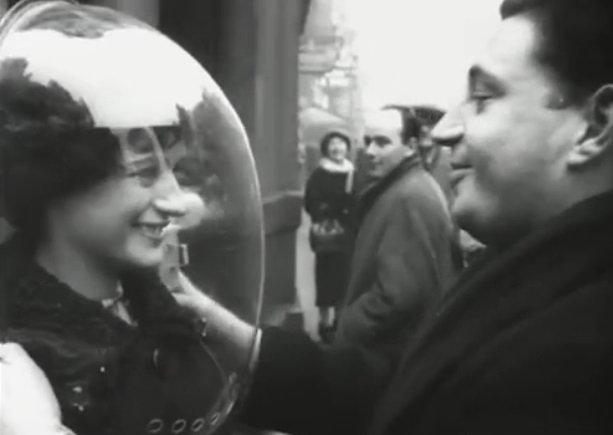Old-school smog solution: Wear a giant fishbowl on your head
02/26/2018 / By Edsel Cook

It’s said those who forget the past are doomed to repeat it. Well, the past is reaching out through an old video of a woman wearing what appears to be a fishbowl on her head as she walked through the smog-choked streets of 1950s London, reported The Daily Mail. (Feature image courtesy The Daily Mail, via still frame from the video at this link.)
At first the black-and-white footage appears to be quirky. The woman is alone in her choice of ludicrous headgear. That’s when a viewer notices what appears to be smoke or smog that’s seemingly everywhere.
The fishbowl was a prototype smog helmet designed to keep out the worst effects of the deadly Great Smog of London that killed thousands of people during the 1950s.
“It’s a smog mask carrying a few cubic beads of pure salubrious air for its wearer to breathe, complete with a candle power defroster,” explained the narrator.
Some of the footage details the use of the odd helmet. A container on the side of the smog helmet holds a wick. Lighting that wick with a match defrosts the material of the headgear, reported The Daily Mail.
The voice-over hails the device as “ingeniously adapted for the wearer’s convenience” while the woman sips tea through a straw.
“All social amenities may be observed,” claimed the narrator. “And sustenance can be taken in. A girl could even fit a new chapeau under that dome.” (Related: Technical solutions for pulling pollution out of the air are distractions that allow both government and industry to keep polluting.)
Straight out of Mordor
The environmental disaster called the Great Smog of London descended upon the British capital during the early weeks of December 1952, reported The Guardian.
A freakish combination of cold weather, an anticyclone, and a lack of wind trapped air pollutants in a dense layer of smog that turned London into a good approximation of Mordor sans fire.
“Weather event,” scoffed Winston Churchill, the Prime Minister of Britain at the time.
The Great Smog killed more than 12,000 people, according to recent research. Most of the fatalities were infants and old people, whose weaker immune systems were overcome by bronchial asthma, pneumonia and other deadly respiratory illnesses.
It asphyxiated cows in the Smithfield Market and surrounding areas, such that their owners fitted gas masks over the snouts of the valuable farm animals for protection.
The Clean Air Act
A chastened British Parliament hastened to pass the Clean Air Act. The legislation was championed by England’s Ministry of Housing and Local Government in England and Scotland’s Department of Health.
Passed in 1956, the Act detailed measures to drastically reduce air pollution and prevent a disaster like the Great Smog from repeating itself. “Smoke control areas” were established in certain towns and cities with high levels of smog. Only smokeless fuels could be burned there. The Act likewise compelled homeowners to heat their homes using cleaner types of coals, electricity or natural gas in order to reduce the number of fires in each household.
Many homes in London complied with the Act by switching to natural gas. There was a corresponding decrease of smoke pollution and a drop in sulfur dioxide levels. Furthermore, the Clean Air Act forced industrial, residential and commercial sectors to look for better ways of generating power. This meant abandoning dirty coal, adopting fuels with cleaner emissions and switching to fuel-efficient vehicles.
It took eight years for the Act to take place. During that time, London endured several more smog-related disasters. The smog event of December 1962, for instance, claimed the lives of 750 people. Two years later, the Clean Air Act finally achieved full effect.
Find out more about the effects of smog on Pollution.news.
Sources include:
Tagged Under: air pollutants, Clean Air Act, Great Smog of London, smog, sulfur dioxide, toxins, weird science




















